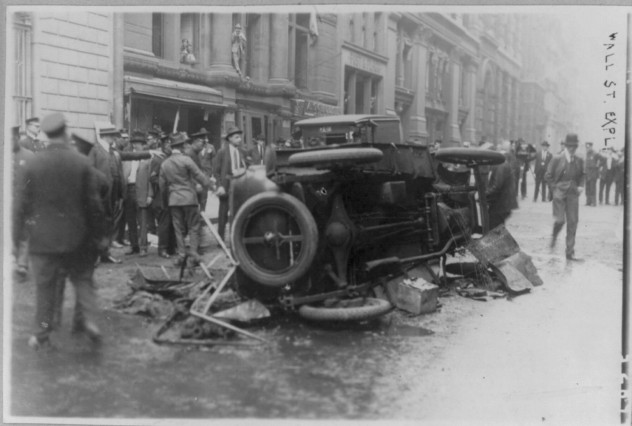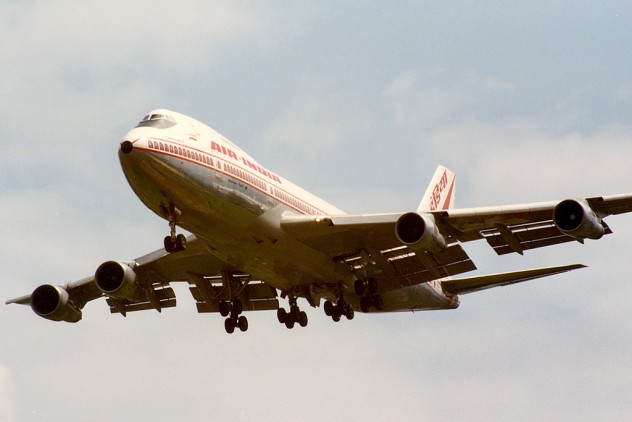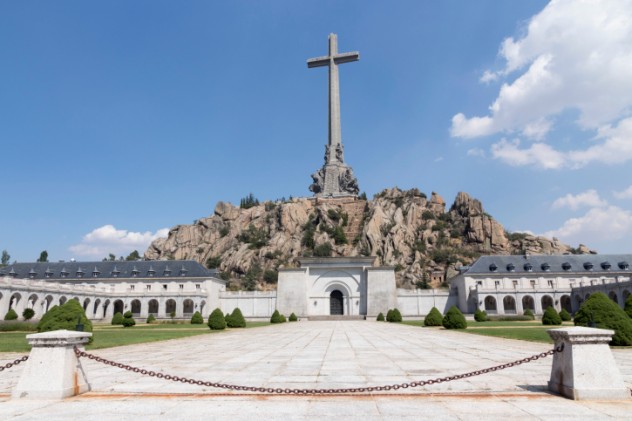 Creepy
Creepy  Creepy
Creepy  Movies and TV
Movies and TV 10 Movies That Get Elite Jobs Right, According to Experts
 Weird Stuff
Weird Stuff 10 Times Real Laws Were Based on Bizarre Hypotheticals
 Animals
Animals 10 Inspiring Tales of Horses Being Human
 Mysteries
Mysteries Top 10 Haunting Facts About the Ghost Ship MV Alta
 History
History 10 Surprising Stories About the Texas Rangers
 Humans
Humans 10 Philosophers Who Were Driven Mad by Their Own Theories
 Miscellaneous
Miscellaneous 10 Video-Game-Worthy Weapons and Armors from History
 Weird Stuff
Weird Stuff 10 Psychics Who Accurately Predicted Wartime Events
 The Arts
The Arts 10 Pieces of Art Inspired by a Broken Heart
 Creepy
Creepy 10 Death Superstitions That Will Give You the Creeps
 Movies and TV
Movies and TV 10 Movies That Get Elite Jobs Right, According to Experts
 Weird Stuff
Weird Stuff 10 Times Real Laws Were Based on Bizarre Hypotheticals
Who's Behind Listverse?

Jamie Frater
Head Editor
Jamie founded Listverse due to an insatiable desire to share fascinating, obscure, and bizarre facts. He has been a guest speaker on numerous national radio and television stations and is a five time published author.
More About Us Animals
Animals 10 Inspiring Tales of Horses Being Human
 Mysteries
Mysteries Top 10 Haunting Facts About the Ghost Ship MV Alta
 History
History 10 Surprising Stories About the Texas Rangers
 Humans
Humans 10 Philosophers Who Were Driven Mad by Their Own Theories
 Miscellaneous
Miscellaneous 10 Video-Game-Worthy Weapons and Armors from History
 Weird Stuff
Weird Stuff 10 Psychics Who Accurately Predicted Wartime Events
 The Arts
The Arts 10 Pieces of Art Inspired by a Broken Heart
10 Awful Terrorist Attacks You’ve Never Heard Of
The Munich Olympics, 9/11, Pan Am 103—these are the terrorist attacks that we are all too aware of. But there are many tragic acts of terrorism that have been largely lost to history.
10 Fraunces Tavern Bombing

Since Puerto Rico’s annexation by the United States, a sizable minority of the territory’s population has advocated for independence, with some trying to obtain this goal through violence. The most prolific pro-independence Puerto Rican terrorist group was the Armed Forces of National Liberation (FALN), which conducted over 130 bombings in the United States to pressure the government to grant immediate Puerto Rican independence.
The deadliest FALN attack occurred at the Fraunces Tavern in the New York City financial district. The Fraunces Tavern is a historic building, having served as the first headquarters for the Department of State as well as the site of George Washington’s farewell address to his troops, but it eventually became a popular restaurant on Wall Street. On January 24, 1975, it was packed with patrons during the lunch hour when, at 1:10 PM, a satchel containing explosives went off near the front entrance, transforming plates and silverware into deadly projectiles. Once the smoke cleared, four people had been killed and over 50 others injured. The FALN left a note on a nearby phone booth claiming responsibility and alleging that the attack was in retaliation for the murder of two Puerto Rican nationalists by the CIA. The actual bombers were never captured, but many other members of the FALN were arrested and convicted of a variety of charges. Ultimately, FALN became defunct, perhaps because like many militants, the group never did speak for the people it claimed to represent—a majority of Puerto Ricans have continuously voted against independence.
9 Khobar Towers Bombing

Thousands of US troops were stationed in Saudi Arabia at the conclusion of the Persian Gulf War to enforce a no-fly zone over Iraq. A large American base was established in Dhahran, with the troops’ quarters located in several high-rise apartment buildings called the Khobar Towers. In the early morning hours on June 25, 1996, a tanker truck containing 11,000 kilograms (25,000 lbs) of explosives parked in a vacant lot next to one of the high-rises, Building 131, and two men jumped out, escaping in a waiting getaway car. Staff Sergeant Alfredo Guerrero was a sentry on the roof of Building 131 and, realizing what was happening, went floor by floor alerting his fellow airmen. He made it down three floors before the bomb exploded, shredding the facade off the eight-story building. The blast killed 19 US airmen and wounded over 300 others, though it is believed the toll would have been much higher if not for Sergeant Guerrero’s actions.
The Saudi government ultimately arrested six men in connection with the plot, though several suspects still remain at large. A team of FBI agents sent to Saudi Arabia to investigate were stonewalled by the Saudi government when it came to interviewing the suspects, and the investigation eventually stalled. The FBI Director at the time, Louis Freeh, later stated that the evidence the agency had been able to assemble pointed to Iran as the most likely sponsor of the attack with the goal of driving US forces from the region.
8 Palace Of Justice Siege

Guerrilla groups in Colombia in the 1980s are like teen supernatural-romance movies today—they were everywhere, and new ones seemed to be sprouting up all the time. This entry involves one of those groups, M-19, an organization composed mainly of students. Founded in 1974, M-19 waged a guerrilla war against the Colombian government for several years, when in 1984 the group and the government entered into a ceasefire. But by the following year, things had soured as M-19 accused the government of violating the terms of the truce. In a brazen response, on November 6, 1985, 35 members of M-19 stormed the Palace of Justice, home to the country’s highest court. Over 300 people were taken hostage, including 24 Supreme Court justices. Meanwhile, police and military units scrambled outside, trying to formulate a rescue plan. The Charry Solano Brigade was the lead military unit on-site, commanded by General Ivan Ramirez Quintero, who had been identified by the US government as a notorious abuser of human rights.
The rebels demanded that President Belisario Betancur come to the Palace of Justice to stand trial for his failure to abide by the terms of the peace agreement. But President Betancur, probably questioning the odds of receiving a fair trial, responded to M-19’s demands by ordering General Quintero to storm the Palace of Justice, a task Quintero pursued with reckless gusto. The building being home to dozens of lawyers and judges, it naturally contained voluminous amounts of legal documents and books, which were set alight when the military attacked with artillery, resulting in a fire that consumed the building. Once the smoke had cleared, over 100 people were dead, including 11 judges and all of the rebels. The Colombian public were shocked by the carnage and the event ultimately led to a renewed peace process between M-19 and the government. Since then, some former M-19 rebels have been elected to the Colombian Congress, while General Quintero was tried and acquitted of murdering several civilians during the military’s assault, though several of his subordinates were convicted.
7 Wall Street Bombing

There was a time in American history when militant anarchists didn’t wear bandannas and smash the windows of Starbucks stores. The United States was gripped by a wave of terrorism during the late 19th and early 20th century. The perpetrators were anarchists seeking the violent overthrow of the government. On September 16, 1920, anarchists struck at the very heart of capitalism in an attack that shocked the nation. A man led a horse-drawn cart through Manhattan and stopped in front of the J.P. Morgan Building, located across the street from the New York Stock Exchange. The driver abandoned the horse and disappeared into the busy lunch hour crowd—he never would be identified. Just after noon, the hundreds of pounds of explosives surrounded by scrap metal loaded in the cart detonated, ripping through the packed streets. The blast claimed 38 lives and wounded another 400.
City officials moved quickly to clean up the site, and in a move that would shock modern forensic investigators, the police hosed down the site of the explosion along with vital evidence. Wall Street was open for business the day after the bombing, and no monument was ever erected to the victims of the attack. Despite a massive investigation, no one was brought to justice for the act of terror, and the desire of government officials and financial elites to quickly move on has largely erased this crime from the public memory.
6 Malaysia Resort Raid

The Philippines is a largely Catholic country, but it has a significant Muslim minority located primarily on the southern island of Mindanao. For decades the Philippine government refused to address Muslim grievances regarding the protection of their rights, which is usually a recipe for confrontation. And so the Philippines suffered from years of conflict as multiple armed separatist groups fought to achieve independence for Mindanao.
Among the most notorious of these groups was Abu Sayyaf, Arabic for “Bearer of the Sword.” Abu Sayyaf had a penchant for kidnapping hostages and ransoming them in order to fund their armed activities against the Philippine government. The group’s most brazen hostage-taking occurred on April 23, 2000 when six armed Abu Sayyaf members landed in speedboats on the Malaysian island of Sipadan, popular among foreign tourists as a dive resort. The group forced 21 people, including 10 foreign tourists and 11 Malaysians, onto their boats and returned to the jungles of Jolo in the southern Philippines.
The rebels managed to elude the Philippine military for months as they were hunted through Jolo. In the midst of the hostage crisis, a Philippine televangelist and 12 followers met with the rebels in an attempt to negotiate a release of the hostages, which in retrospective was a shortsighted move, since the religious extremists preferred to take them all hostage rather than negotiate. In the end, the crisis was resolved when Libyan dictator Muammar Gadhafi intervened and obtained the hostages’ release in exchange for a payment of millions of dollars to Abu Sayyaf. In subsequent years, the larger Muslim separatist groups entered into negotiations with the Philippine government, but Abu Sayyaf continues its campaign of terror.
5 Air India Flight 182

Beginning in the 1970s, Sikh separatists commenced an armed struggle seeking the creation of an independent homeland in India called “Khalistan.” The movement for a free Khalistan culminated with Operation Blue Star in 1984 when the Indian military raided the Golden Temple, the holiest site in the Sikh religion, in order to arrest suspected militants located there. Unfortunately, they killed hundreds of innocent Sikhs in the process. Operation Blue Star was viewed by many Sikhs as a direct assault on their religion by the Indian government, and Sikh separatist groups began formulating their revenge.
The Sikh militant group Babbar Khalsa exacted its horrific retribution on June 23, 1985 when a Canadian member of the group entered Vancouver International Airport and checked in two suitcases, one onto Air India Flight 301 to Tokyo and another onto Air India Flight 182 to Mumbai. Each suitcase contained a powerful bomb hidden inside of a radio. The bomb destined for Flight 301 exploded prematurely at Tokyo’s Narita International Airport, killing two baggage handlers. But the bomb aboard Flight 182 exploded while the plane was traveling at 31,000 feet off the coast of Ireland, destroying the plane in midair. All 329 people on the flight were killed, making the attack the worst mass murder in Canadian history as well as the deadliest terrorist attack ever until 9/11. The Canadian government had difficulty tracking down the perpetrators and obtaining enough evidence against them. In the end, only one person was ever tried in relation to the bombing, Inderjit Reyat, and even then the government was forced to enter into a plea deal that resulted in Reyat copping to a single count of manslaughter and receiving a five-year sentence.
4 Bologna Train Station Bombing

Italy in the ’70s and ’80s was plagued by a dysfunctional and corrupt government, which is similar to present-day Italy, but with one key difference: These decades saw the country consumed by bombings and assassinations committed by groups from across the political spectrum in a period that has fittingly been dubbed the Years of Lead. The deadliest act during the Years of Lead occurred on August 2, 1980 when a suitcase containing 20 kilograms (40 lbs) of explosives detonated in the middle of a packed waiting room at Bologna’s main train station, obliterating the station, killing 85 people, and injuring 200 more.
Four members of a neo-fascist terrorist group were ultimately convicted for their role in the attack. More troubling was the assistance two Italian secret service agents provided to the men behind the attack. It is conjectured that the bombing was part of a dark collusion between the Italian security services and right-wing terrorists to prevent the powerful Italian Communist Party from winning majority support at the polls.
3 The October Crisis

Given Canada’s modern peaceful and progressive reputation, it may be hard to believe there was a time when a campaign of terror led to troops patrolling the streets of Canadian cities. But that is exactly what happened in late 1970 when Front de liberation du Quebec, a group fighting for independence for the province of Quebec, embarked on a terror campaign that rattled Canada to its core. The FLQ had previously engaged in bombings, including an attack on the Montreal Stock Exchange that injured 27 people, but on October 5, 1970 they switched tactics to hostage-taking when two armed members of the group took James Cross, the British Trade Commissioner, hostage outside of his home. Less than a week later, the FLQ abducted Pierre Laporte, the Quebec Minister of Labor, and held him at an undisclosed location. In exchange for their hostages, the FLQ demanded the release of 23 “political prisoners,” $500,000 in gold, the broadcast of the group’s manifesto, and safe passage for the hostage-takers to Cuba.
Canadian Prime Minister Pierre Trudeau responded by invoking the War Measures Act, which suspended certain civil liberties in the face of insurrection. Thousands of troops were dispatched to Quebec to guard government officials and property, and over 1,000 raids against suspected FLQ members were conducted, with 450 people arrested. In response to the invocation of the War Measures Act, the FLQ murdered Laporte, leaving his body in the trunk of a car near an airport in Montreal. The crisis ended in December 1970 when Cross was released in exchange for his captors being permitted to leave the country for Cuba, while the FLQ members that murdered Laporte were arrested and tried for their crimes. The FLQ members that fled to Cuba would eventually return to Canada and receive short prison sentences, while Laporte’s murderers were released from prison by the early ’80s. After abandoning their poorly conceived crusade for independence, many of the former FLQ members went on to become prominent writers, filmmakers, and politicians.
2 Operation Ogre

In 1973, Spain was in the grip of its third decade under Francisco Franco’s dictatorship. Franco had appointed one of his closest allies, Admiral Luis Carrero Blanco, to the post of prime minister, and many believed Blanco would succeed Franco as leader of Spain. Blanco only served as prime minister for a few months when his term was cut short by ETA, a group fighting for independence for the Basque region of northern Spain.
On December 20, 1973, three members of ETA posing as electricians monitored a road in Madrid that Blanco used every day on his way to church. The cell had spent months digging a tunnel under the road in which were concealed over 45 kilograms (100 lbs) of explosives. When Blanco’s Dodge Dart passed over the tunnel, the “electricians” set off the bomb, blowing Blanco’s car over a four-story building and landing it on the other side, killing Blanco, his chauffeur, and a bodyguard. Franco’s carefully laid transition plans were thwarted by the assassination, and many have speculated that Blanco’s death facilitated Spain’s return to democracy.
1 Oregon Salmonella Attack

Oregon has long attracted members of the counterculture, but most of those people don’t go on to commit bioterrorism. Not so with the Rajneeshee cult, a New Age movement whose 2,000 members moved to a farm in rural Oregon in the early 1980s with the goal of establishing a utopian commune. The group initially maintained good relations with their neighbors, but things soured when the Rajneeshees began building structures on their property (ranging from shopping malls to medical laboratories) which somewhat conflicted with the agricultural use of the surrounding land. The Rajneeshees soon found themselves under pressure from county officials to curb their unauthorized land use.
In response, the Rajneeshees decided to organize for the coming county elections with the goal of gaining a majority of the seats on the county commission. But rather than go through the tedious work of registering voters and engaging the public, the Rajneeshees decided an easier way to win would be to poison enough people to depress turnout and allow their candidates to win. So, in the fall of 1984, the Rajneeshees laced the food at several salad bars in The Dalles with the potentially deadly salmonella bacteria that they had manufactured in the labs at their commune. A total of 751 people were sickened, with 45 requiring hospitalization. Federal investigators initially attributed the outbreak to the food handlers at the salad bars, and it wasn’t until several Rajneeshee members turned informants that investigators learned the truth. Several members of the Rajneeshee were tried in connection with the attack, but they all served less than three years for the first bioterrorist attack in modern history.
Anthony is a full-time attorney and part-time comedy writer. He resides in the vast urban sprawl outside of Las Vegas.








